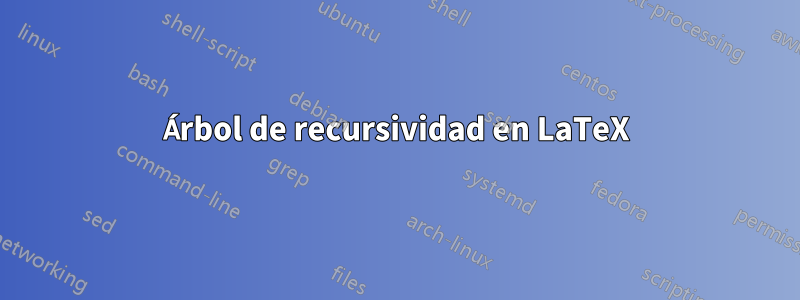
Respuesta1
Puedes usar el poderosoforestpaquete; Incluso puedes dejar los cálculos del contenido al paquete:
El código:
\documentclass[border=5pt]{standalone}
\usepackage{amsmath}
\usepackage{forest}
\begin{document}
\begin{forest}
for tree={
parent anchor=south,
s sep=2pt
},
delay={for descendants={
if n=1
{draw,content/.wrap 2 pgfmath args=
{$c\binom{n}{#2}^{2}$}{content}{int(2^level)}}
{if n'=1{draw,content/.wrap 2 pgfmath args=
{$c\binom{n}{#2}^{2}$}{content}{int(2^level)}}{}
},
where n children={0}{draw,content=c}{}
}
}
[$cn^{2}$,draw
[
[
[
[]
[]
[]
]
[
[,phantom]
]
[
[,phantom]
]
[
[]
[]
[]
]
]
[
[,phantom]
]
[
[,phantom]
]
[
[
[]
[]
[]
]
[
[,phantom]
]
[
[,phantom]
]
[
[]
[]
[]
]
]
]
[
[,phantom [,phantom]]
]
[
[,phantom [,phantom]]
]
[
[
[
[]
[]
[]
]
[
[,phantom]
]
[
[,phantom]
]
[
[]
[]
[]
]
]
[
[,phantom]
]
[
[,phantom]
]
[
[
[]
[]
[]
]
[
[,phantom]
]
[
[,phantom]
]
[
[]
[]
[]
]
]
]
]
\end{forest}
\end{document}
Respuesta2
forestle permite especificar un árbol usando notación de corchetes estándar. Vermi respuesta a una pregunta anteriorpara obtener una explicación de cómo convertir un árbol en una especificación usando notación entre corchetes. Otras respuestas cubren otros paquetes adecuados para dibujar árboles simples (como se especifica en la pregunta). Entonces, si no te gusta forest, quizás alguno de los otros te convenga.
Para forest, aquí hay un prototipo para comenzar:
\documentclass[tikz,border=10pt]{standalone}
\usepackage{forest}
\begin{document}
\begin{forest}
for tree={
draw,
align=center
}
[root
[child
[grandchild
[great\\-grandchild]
[great\\-grandchild]
[great\\-grandchild]
]
[grandchild, calign with current]
[grandchild
[great\\-grandchild]
[great\\-grandchild]
[great\\-grandchild]
]
]
[child
[grandchild
[great\\-grandchild]
[great\\-grandchild]
[great\\-grandchild]
]
[grandchild, calign with current]
[grandchild
[great\\-grandchild]
[great\\-grandchild]
[great\\-grandchild]
]
]
[child
[grandchild
[great\\-grandchild]
[great\\-grandchild]
[great\\-grandchild]
]
[grandchild, calign with current]
[grandchild
[great\\-grandchild]
[great\\-grandchild]
[great\\-grandchild]
]
]
[child
[grandchild
[great\\-grandchild]
[great\\-grandchild]
[great\\-grandchild]
]
[grandchild, calign with current]
[grandchild
[great\\-grandchild]
[great\\-grandchild]
[great\\-grandchild]
]
]
]
\end{forest}
\end{document}





